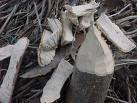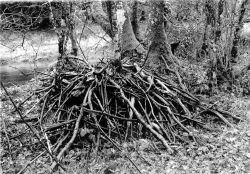The ancient landscape of North Knapdale, was forged and folded by gigantic elemental forces and left to slumber through time as wind and weather carved and eroded the land. Early man lived his life governed by the seasons, his impact on the landscape a fugitive collection of rock elements so discrete they are still being discovered. The only way we know he was here. There followed an aggressive assault by later settlers, with de-afforestation for the making of charcoal, debarking for tanning, ground clearing for crops, then re-afforestation for pit props, woodchip and pulp, leading to acre upon acre of spruce, such that the form of the land was lost. Settlements were abandoned and shattered by the relentless march of the conifer. Until the day someone realised what was being destroyed, and the slow, slow reversal of that short-sighted planting policy brought about a recognition of the value of mixed woodland, and the ecological importance of Atlantic oakwoods for the survival of many species. Natural regeneration was encouraged and the landscape emerged from the conifer shroud. People stood amazed at what they had reclaimed and it became a precious and wonderful thing in their lives, a cherished and protected part of their very existence. Large and small organisations laid claim to different parts, different elements, and saving the landscape became a business and experts appeared and became the most common and irritating life form in the land. In spite of this, thousands of people continued to visit, to live, love and die there. To many people the world over, Knapdale is their spiritual home. The tranquil beauty, the rugged hills and soft hollows, the rainshine on rock face, the baking heat of summer days, the gold, rose and russet of autumn, the fierce winter storms, the manic dashing rain – sights such as these slip secretly into ones’ soul and memory, to be savoured at more stressful times.
Man has learned at last to lift his heavy foot and tread softly, at last learned that the land can heal itself if left to its own devices. Oh dear Lord, if only this were so.
For reasons wholly bureaucratic it is proposed that one of the most destructive animals in Europe – an animal reviled widely where introduced, an animal that costs its host country thousands upon thousands of pounds-worth of damage – be deliberately released into a few hundred acres of North Knapdale. Released into a chain of secluded lochans that lie jewel-like in the folds of the hills above Barnluasgan. These small lochs support resident populations of fish, amphibians, reptiles, insect life and aquatic plants; many of them are protected, such as the Adder, some of them are rare, like the Least Water-lily. It is into these thriving ecosystems that men, driven by an imperative they refuse to explain, intend to release beaver, just to see what it will do and how it will do it. The subsequent irreversible destruction of existing habitat is dismissed as of no consequence in the pursuit of quota-driven objectives.
If you love wildlife, if you love the countryside, if you love Knapdale, if you love Argyll, if you love Scotland, please write to your MSP or MP, write to Mike Russell the minister responsible and in favour of this ludicrous endeavour, write to them demanding that the application for this introduction be thrown out.
Thank you.
Thursday, 25 October 2007
Subscribe to:
Post Comments (Atom)









No comments:
Post a Comment